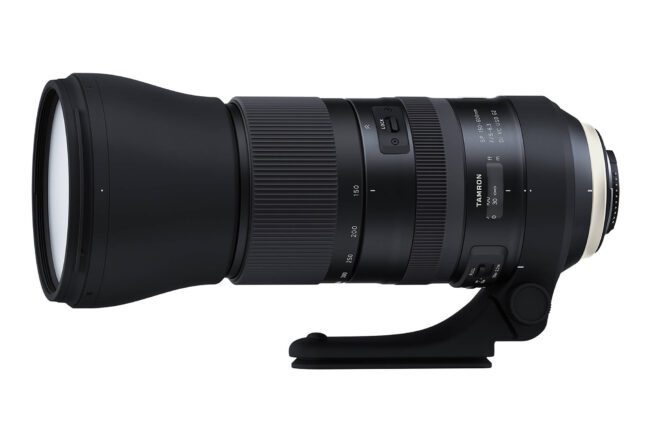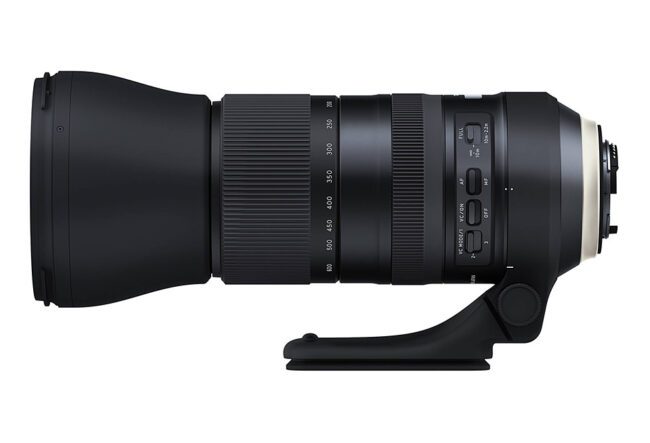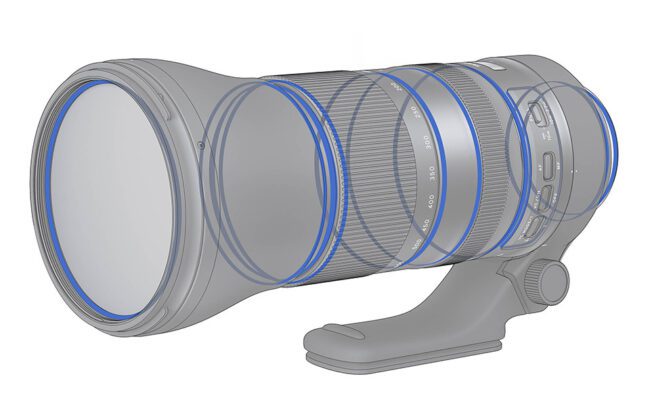Does Tamron Lens Freeze Up Nikon Camera
When Tamron introduced the Tamron SP 150-600mm f/5-6.3 VC a few years ago it really shook things up (Model A011, but hereafter I'll call it the G1 for simplicity). Priced only over a grand, the G1 offered people the chance to get into wildlife photography without dumping five figures into a super-telephoto prime number lens. Not only was it inexpensive, just it was also surprisingly abrupt also; much sharper than many of us expected a lens in that price range to be. Sigma followed up a few months later with not one, merely two 150-600mm zooms, and so Nikon joined the fray a twelvemonth later with its Nikon 200-500mm zoom.

While the Tamron 150-600mm f/5-vi.3 VC did cracking optically, it suffered autofocus freeze-up problems with Nikon bodies and the long barrel extension coupled with a lack of weather condition-sealing fabricated it a real dust pump. Withal, the lite weight, skillful paradigm stabilization and general paw-holdability of the lens fabricated it a keeper in my volume. With the Tamron 150-600mm f/5-vi.3 VC, I could accomplish locations I wouldn't lug a 500mm or 600mm prime to. It focused quickly and tracked reasonably well for birds in flight too. Overall, it got me a lot of shots I wouldn't have gotten otherwise.
Nevertheless, those AF freeze-ups bellyaching the hell out of me, then when Tamron announced a new 150-600mm zoom (designated the G2 for Generation 2) that was weather sealed and boasted improved autofocus operation, I jumped at the gamble to field test one even though the MSRP jumped to $ane,399. In addition, Tamron has released dedicated 1.4x and 2x teleconverters for this lens. I tested the one.4x (MSRP $419), but gave a pass on the 2x as this would let and so little lite in (f/13 maximum aperture at 1200mm) that I doubt even in brilliant light that it would autofocus and at f/13 the viewfinder would be and so dark equally to make manual focus difficult, forcing you to use alive view – non ideal for wildlife.

Key Features and Improvements
Below is the list of key features and improvements on the Tamron SP 150-600mm G2:
- The G2 rocks a revamped optical formula with a whopping 21 elements in 13 groups, iii of the elements are low dispersion glass
- New AF system is claimed to be faster than previous model (which was pretty fast already)
- 2.2m minimum focusing distance – ane:three.9 maximum magnification for close-ups
- iv.5 stops of vibration reduction – choice of three VR modes (Tamron calls their vibration reduction VC, for vibration command)
- eBAND coating – this is Tamron's version of what Nikon calls Nano blanket
- Fluorine coating on front end element
- Full atmospheric condition sealing
- Electromagnetic diaphragm
- Tripod collar with Arca-Swiss compatible grooves
- Metal lens butt
- Optional TAP-in console to update firmware and customize AF and VC settings
Wow, it sounds like Tamron has really listened to the market and is offering all the latest perks consumers desire. Just accept they delivered? Permit's discover out.
Build and Ergonomics
Out of the box, the build feels good and the lens balances well on all the bodies I attached to it (Nikon D500 with and without battery grip, D810, and D4s). Tamron has fabricated the lens barrel from metal, not plastic. For some, this is a selling point, simply I don't experience it matters when it comes to whether I get the shot or not. The only complaint I have about the build is that the switches are non positive enough. On the G1 there was a very distinct click, and switching modes felt deliberate and positive, however, to button them into place information technology helped to take the camera away from your face. The G2 switches are easier to manipulate if you're looking through the viewfinder. Simply a light touch moves from mode to way. Only it'due south this light touch that causes problems when you accidentally nudge the focus limiter to the wrong range and miss a shot because the lens won't focus beyond a certain distance. The light activeness on these four switches (VC mode, VC on/off, AF/MF and focus range limiter) makes the switches feel inexpensive. As I use rear-push focus, the AF/Chiliad switch becomes redundant, so I ended up taping it in identify, considering I inadvertently bumped out of AF multiple times. Though all of the switches are prone to being nudged out of place, the AF on/off and focus limiter switches, due to their position on the lens barrel, seemed to get bumped more than the VC manner and VC on/off switches.

Total zoom takes most 160 degrees, or for me 2 skilful twists (might take 3 if your fingers are shorter than mine). The zoom ring action has an fifty-fifty feel with no tight spots. If you really demand to zoom in or out in a bustle, you tin can grasp the front of the butt and push or pull as needed. I avoided this with the G1 as I worried it would pump more dust into the lens interior. With the G2'southward weather sealing, this should be less of a concern. When using the button/pull technique there seems to be more resistance the further you zoom out.
There is both a zoom lock switch and a new Flex Zoom Lock. The zoom lock switch works only at 150mm. The Flex Zoom Lock utilizes a slight pull outwards of the zoom ring to lock the barrel at any focal length. I personally didn't like this feature as it was easy to unintentionally lock the butt and not realize it, just to terminate upward in a state of affairs where you desire to zoom and tin can't. I'g sure I'll become used to this with more utilize and I see where this could be helpful say when panning and you don't want to focal length to change image to epitome, ditto with chimping and raising the lens back upwardly for the next shot of the aforementioned subject. The lens exhibits minor zoom pitter-patter, mostly between 150-300mm. Beyond 300mm, y'all really have to bounciness around to get it to creep.

The manual focus band is also smooth, but I wish it were wider and easier to find. When hand-property, I like to support the lens by the tripod pes and the focus ring is a scrap tricky to grab in this position. If you lot support by belongings the lens butt, then the focus ring is easier to take hold of. The focus scale goes from near (left) to infinity (right), same as Canon, opposite of Nikon. As Canon outsells Nikon, I don't blame Tamron for making this manufacturing option, simply I wish they would contain same direction focusing for both platforms. Of form this would drive the price upwardly, perhaps beyond what consumers would want to pay for this feature.
The tripod foot is a big improvement over the G1. It'due south longer, with room for all four of my fingers (the G1 had room for just 3 fingers). Furthermore information technology has Arca-Swiss uniform grooves. Finally a lens manufacturer has incorporated this design that has been the pro standard for quite some fourth dimension. This should work great with screw lock Arca-Swiss style tripod head connections. With my Actually Right Stuff quick release, the fit was uncomfortably tight. Really Right Stuff machines all their gear to their own specifications and I've noticed Arca-Swiss plates from other manufacturers don't always mate well with Really Right Stuff, sometimes existence too tight or also loose. Seems like there isn't exact agreement on just how wide the Arca-Swiss standard is, or that this is an issue of manufacturing tolerances. Some other nice feature of the G2 tripod foot is information technology at present has 2 screw holes instead of one similar the G1. So if you practice add together a two-spiral tripod plate to information technology, that connection won't twist at all.
Rotating the lens in the collar when mounted on a tripod can be a grabby proposition depending on how well balanced y'all're set up on your tripod and on if you have a heavy or lite body attached. This is typical of tripod collars in full general, except for those with roller bearings and such collars are usually merely seen on high-finish lenses costing over ten m.
The lens hood on the G1 was pretty fussy to attach and reverse on the lens. The G2's hood is easy to attach. It's a tad fussy to reverse for storage, but not most as bad equally the G1.

Afterward shooting this lens for four months, there is no observable dust inside then the conditions sealing seems to work well. As you can meet from the above illustration, Tamron did a pretty skilful job with weather sealing the lens. In comparison, the G1 in an equivalent length of fourth dimension would collect a lot of dust inside.
First Impressions
My first field experience wasn't skillful. While out shooting, the G2 seemed to hunt focus a lot more than my G1. I had caused the TAP-in panel with the hope that I could fine-melody things like AF speed (Sigma's similar dock lets you lot practise this), but it turns out it but lets you lot accommodate the AF focus limiter switch settings (and some VR settings) and upload firmware updates.
I wasn't psyched to be missing shots because of focus hunting, but when I got back dwelling house and loaded downward images I was pleased with the sharpness. Furthermore, the more I got familiar with the lens, the less hunting it did as I made adjustments to my technique.

Source: https://photographylife.com/reviews/tamron-sp-150-600mm-f5-6-3-g2
Posted by: swisherequat1983.blogspot.com


0 Response to "Does Tamron Lens Freeze Up Nikon Camera"
Post a Comment